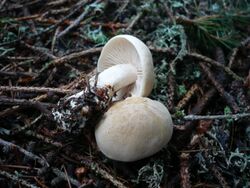Biology:Tricholoma inamoenum
From HandWiki
Short description: Species of fungus
| Tricholoma inamoenum | |
|---|---|

| |
| Scientific classification | |
| Domain: | Eukaryota |
| Kingdom: | Fungi |
| Division: | Basidiomycota |
| Class: | Agaricomycetes |
| Order: | Agaricales |
| Family: | Tricholomataceae |
| Genus: | Tricholoma |
| Species: | T. inamoenum
|
| Binomial name | |
| Tricholoma inamoenum (Fr.) Gillet (1878)
| |
| Synonyms[1] | |
| |
Tricholoma inamoenum is a mushroom of the agaric genus Tricholoma found through the Northern Hemisphere, particularly under conifers.[2] It is poisonous, and is characterized by an unpleasant odor resembling coal gas or tar.[3][2] • Analysis of the volatile compounds emanating from fresh sporocarps using solid phase microextraction (SPME) showed the odor compounds responsible for the coal tar odor of this mushroom are 1-octen-3-ol and indole. [4]
Seattle's Tricholoma platyphyllum may be the same species. A similar species is Tricholoma sulphureum, which is found under both conifers and hardwoods.[2]
See also
- List of North American Tricholoma
- List of Tricholoma species
References
- ↑ "Tricholoma inamoenum (Fr.) Gillet :112, 1874". MycoBank. International Mycological Association. http://www.mycobank.org/BioloMICS.aspx?Table=Mycobank&Rec=27393&Fields=All. Retrieved 2013-03-23.
- ↑ 2.0 2.1 2.2 Trudell, Steve; Ammirati, Joe (2009). Mushrooms of the Pacific Northwest. Timber Press Field Guides. Portland, OR: Timber Press. pp. 103-104. ISBN 978-0-88192-935-5. https://books.google.com/books?id=WevHvt6Tr8kC.
- ↑ Miller Jr., Orson K.; Miller, Hope H. (2006). North American Mushrooms: A Field Guide to Edible and Inedible Fungi. Guilford, CN: FalconGuide. pp. 124. ISBN 978-0-7627-3109-1.
- ↑ Wood W. F.; Largent D. L.; Henkel T. W. (2004). "Headspace analysis identifies indole and 1-octen-3-ol as the "coal tar" odor of ‘’Tricholoma inamoenum’’". Mycological Progress 3 (4): 325-328. doi:10.1007/s11557-006-0102-z.
Wikidata ☰ Q10570608 entry
 |

